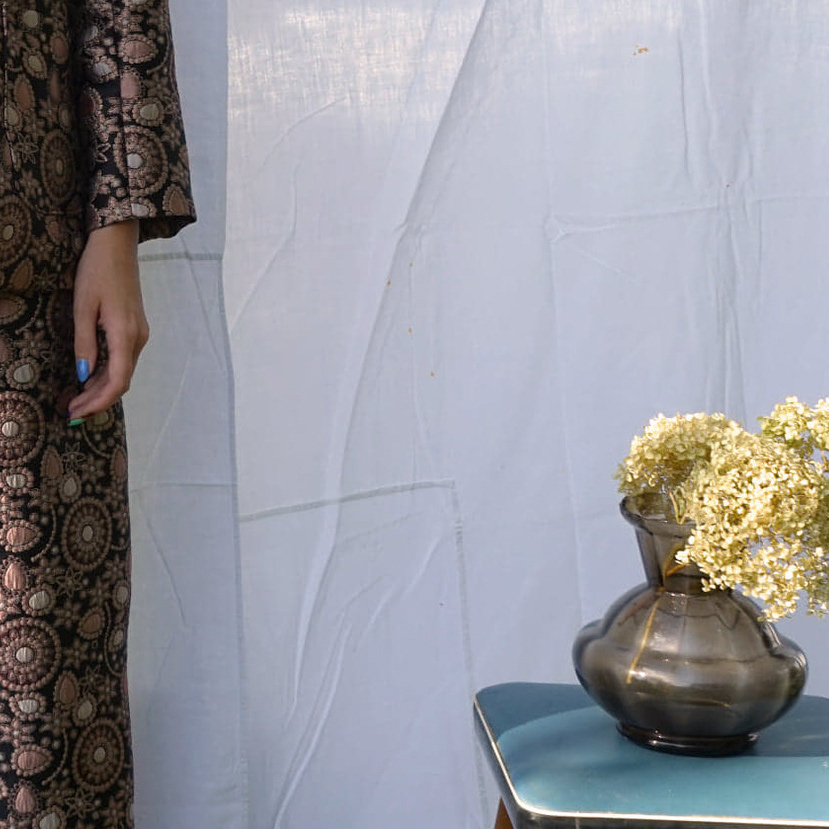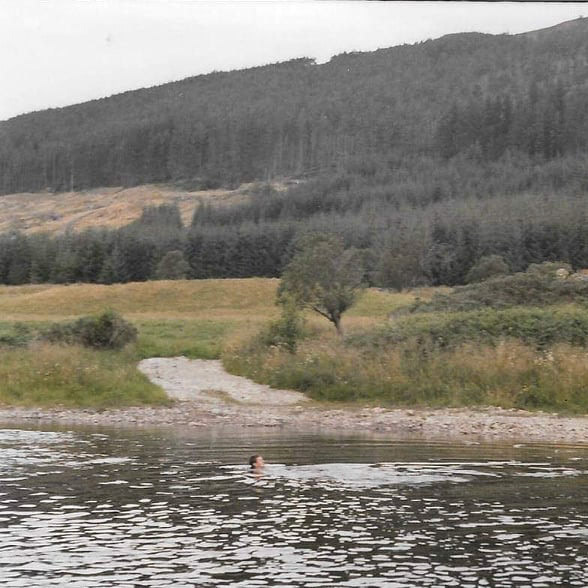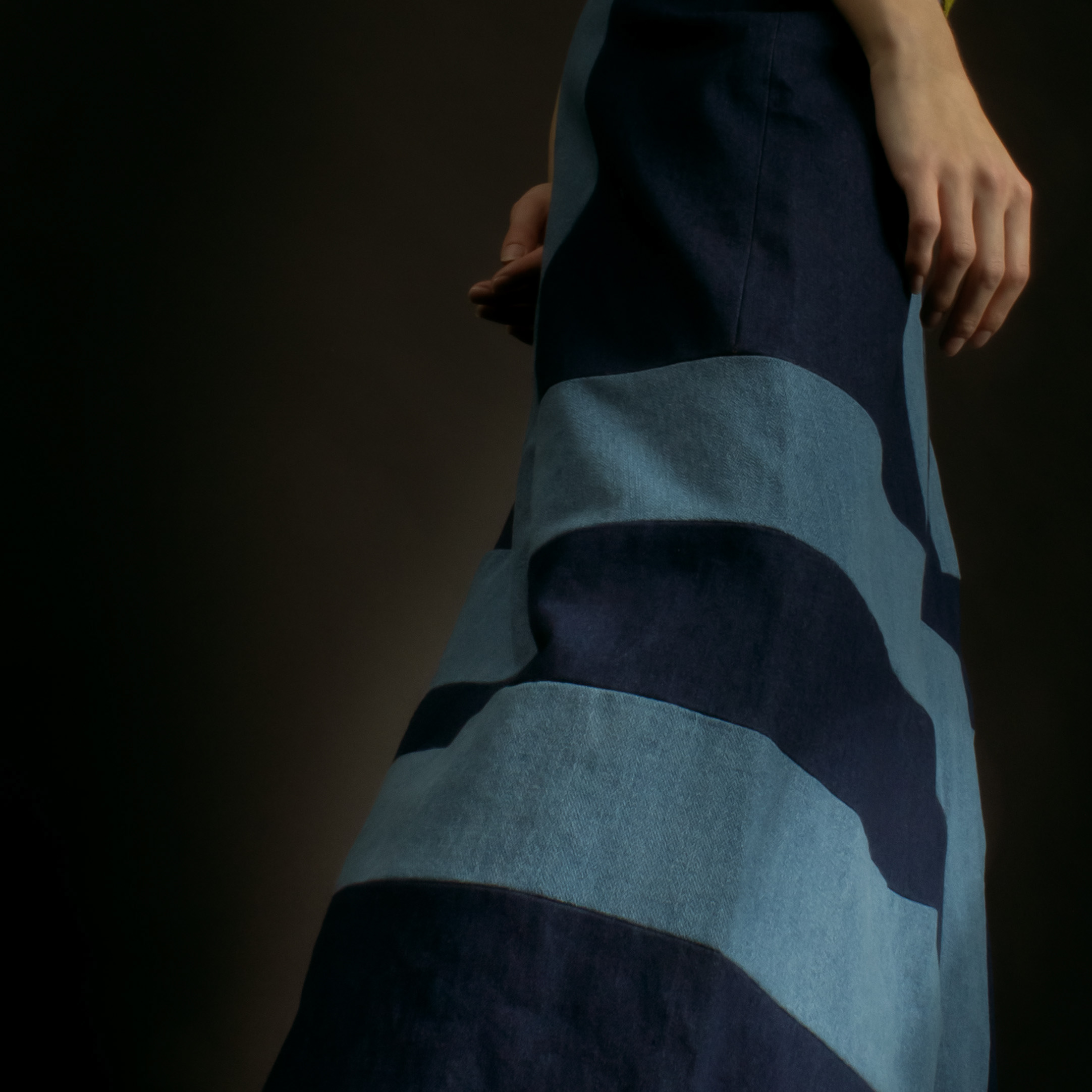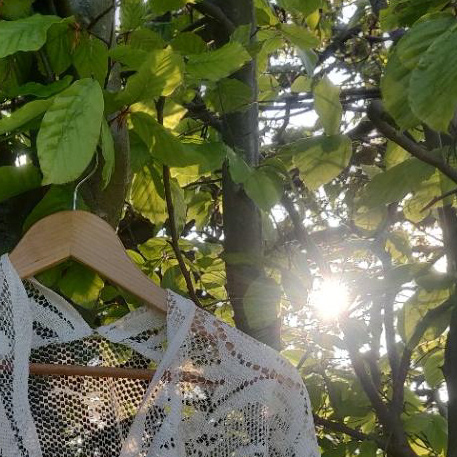As part of the Smart Design project, I drew up the brand KARADA together with Helena Vanwalle, Camille Verhoest, Nina Vandenbrande, Emma Van Lerberghe and Mira François. For this project, we design a creative, sustainable and innovative product according to the principles of the circular economy.
In this project, I mainly focus on the creative & visual aspects, such as designing, the mood boards and the corporate identity. In addition, I am also involved in sustainability and the choice of materials within Karada.
OUR MISSION
“Our mission is to develop a fashionable and circular garment that women feel strong in. We try to create a product that pays attention to an important social problem surrounding sizes through our creativity and passion for fashion. Women come into contact with this daily, and we want to remove uncertainties with our garment in a sustainable way.”
- The six of Ghent
CONCEPT DESCRIPTION & TARGET GROUP
Figure 1: Logo Karada (Karada, 2021)
Our concept includes an online store where sustainable and circular clothing is sold. Our brand does not work with traditional sizes, because there is only one size. We do this to address today's uncertainties about the body. We want to offer our customers a way out of these uncertainties, by making transformable clothing.
A design will be made in one size, this size includes all sizes from 34 to 46. Utilizing zippers, buttons, ribbons... the garment will be transformable so everyone can determine their prefered fit. To help customers with this, an app or website will be developed in which all possible transformations are explained. We will only work with a website, there is no physical store, this choice was made because the target group is mainly active online. Our target group is the well-to-do woman between 18 and 35 years old between sizes 34 and 46 who attaches importance to sustainability and is fashion-conscious.
CREATIVE & VISUAL ASPECT
- CORPORATE IDENTITY -
KARADA's house style is characterized by the influence of modern Japanese fashion. We mainly got inspiration from the street style of Tokyo. We chose this style because it has a very timeless and minimalist look. It is very important to us that our garment is timeless because something that is too trend-bound is immediately less durable. We are inspired by the traditional clothing of Japan and its influence on Western fashion.
Figure 2: Mood board corporate identity
- COLOURPALETTE -








- SHI -
Our collection is named after the Japanese numbers. The design shown on the right is the fourth design, called SHI.
In my design, zippers in the front are used to narrow or widen the waist. In the back, there is a similar system to give more comfort in movement. The sleeves are adjustable by threading a ribbon through the different buttonholes. Our brand name is embroidered on the left shoulder seam in the same accent colour as the zippers.
Figure 3: SHI
SUSTAINABILITY
- TEXTILE FILE -
The textile file lists all the materials needed for the production of the shirt “Ichi”.
First of all, we look at the needs of our design, so we can choose the right materials based on that. The materials are explained in terms of sustainability during extraction and production and whether or not the material can be recycled. A further explanation is also given for the eco-labels if this is applicable to the material. Ultimately, it is checked whether the chosen materials actually meet the predefined needs of the design and concept.
Needs of the design and concept:
- Not translucent
- Comfortable
- Easy maintenance
- Long lifespan
- Sustainably produced
- Recyclable/reusable
Selected materials:
- Fabric: light organic cotton gabardine
- Adhesive: Vlieseline F220
- Buttons: Freshwater Mother of Pearl buttons
- Sewing thread: Scanfil Organic Cotton
- Ribbon: from residual fabric
Figure 4: Light gabardine made of organic cotton (Ecotex, n.d.)
BASE FABRIC
The fabric we chose is a light organic cotton gabardine, ideal for a shirt that can be worn all year long.
This fabric can be recycled as it is made from organic cotton. However, after recycling a few times, the fibres lose their quality. This can be solved by making a mixed fabric of both recycled and virgin cotton. Recycling is made more difficult by applying adhesive to the fabric, about which more later.
We chose this fabric mainly because it has a GOTS certificate, which indicates certain durability of the material. Synthetic crop protection products, genetically modified organisms and fertilizers are not used in the production of a substance with said certificate. In addition, the production also consumes less water and energy and fewer greenhouse gases are created. No harmful substances may be used during painting. On a social level, a GOTS certificate offers attractive advantages as well: a minimum wage must be met, there is a ban on child labour and it ensures a safe and hygienic working environment (Why biological substances and what is GOTS?, n.d.).
The cotton fibres of this fabric come from the Izmir region of Turkey. In the same region, the fibres are also directly processed into yarn and woven into gabardine (Ecotex, n.d.).
We purchase this fabric from Ecotex, a Dutch textile wholesaler that specializes in sustainable fabrics and haberdashery.
This fabric can be recycled as it is made from organic cotton. However, after recycling a few times, the fibres lose their quality. This can be solved by making a mixed fabric of both recycled and virgin cotton. Recycling is made more difficult by applying adhesive to the fabric, about which more later.
We chose this fabric mainly because it has a GOTS certificate, which indicates certain durability of the material. Synthetic crop protection products, genetically modified organisms and fertilizers are not used in the production of a substance with said certificate. In addition, the production also consumes less water and energy and fewer greenhouse gases are created. No harmful substances may be used during painting. On a social level, a GOTS certificate offers attractive advantages as well: a minimum wage must be met, there is a ban on child labour and it ensures a safe and hygienic working environment (Why biological substances and what is GOTS?, n.d.).
The cotton fibres of this fabric come from the Izmir region of Turkey. In the same region, the fibres are also directly processed into yarn and woven into gabardine (Ecotex, n.d.).
We purchase this fabric from Ecotex, a Dutch textile wholesaler that specializes in sustainable fabrics and haberdashery.
ADHESIVE
We chose Vlieseline F220 for the durability of the product and its properties. This adhesive weighs 43g/m² and is rather thin, which is ideal for a shirt made of gabardine.
Vlieseline F220 is an adhesive made of 100% recycled polyester. We chose recycled polyester because it is difficult to recycle or reuse the adhesive itself and the fabric to which the adhesive has been applied. Even if one were to remove the adhesive from the adhered pattern pieces, adhesive residue will still remain. Recycled polyester could, however, still be recycled if there are no glue particles on it (which is not the case with this adhesive), but also only a few times, such as with cotton recycling. The molecular structure degrades after too much recycling, making it unsuitable for yarn production. The recycling of polyester is in fact very interesting because it saves fuel. After all, crude oil is not renewable. In addition, it also ensures lower energy consumption, lower greenhouse gas emissions and reduces the huge mountain of waste (Janssens, 2019).
This adhesive is Oeko-tex certified: the end product, therefore, contains no harmful substances and meets the standards for colour and wash resistance (Label info, n.d.).
We purchase the adhesive from Fournituren Zakelijk, a Dutch wholesaler in haberdashery.
Figure 5: Vlieseline F220 (Vlieseline, n.d.)
Figure 6: Freshwater Mother of Pearl (Luméa, z.d.)
BUTTONS
The buttons we use for this project are recycled from freshwater mother-of-pearl shells. We chose these because they are produced by a very transparent and sustainable company. The only downside is that the company is based in New Zealand.
The shells are fished in China by local farmers who work traditionally and according to local fishing laws. Luméa, the company that produces these buttons, calls this work according to Kaitiakitanga: this is a New Zealand term for taking care of the environment and the processes and activities surrounding it (Luméa, n.d.).
YARN
We have chosen an organic cotton yarn from Scanfil to make recycling easier. If we were to work with synthetic yarn, all kinds of problems would arise when we want to recycle the fabric.
Just like the fabric, the yarn has a GOTS certificate. This means that no harmful substances were used here either during the growth of the cotton plant, the processing of the fibres, the spinning and the dyeing of the yarn. This yarn is produced in Italy, the fibres come from the Egyptian cotton plant.
We buy this yarn on 5000m bobbins at Pure Fabricz. They specialize in sustainable fabrics and haberdashery. They sell this yarn in 34 different colours, on 100m or 5000m spools.
Figure 7: Scanfil Biocotton (Pure Fabricz, n.d.)
Figure 8: Threading system in the back (Karada, 2021)
RIBBON
The ribbon that is used in the threading system in the back and the front is made from residual fabric from the shirt itself. In this way, we reduce fabric waste and we are not dependent on an additional supplier.
Since it is made of the same material, our garment will also look more minimalist than if we bought a ribbon that will never be 100% the same colour and texture as the shirt itself. It also ensures that there is less friction, which makes the ribbon less likely to loosen or shift. With a satin ribbon, for example, the knot would come off much easier.
To obtain a nice, uniform finish, we make this ribbon using a loop turner. With this method, we make a ribbon about 6mm wide.
PITFALLS
Despite the long search for materials that are as sustainable as possible, we still have some pitfalls in our material choices, which we hope we can solve with time. We have always considered whether the pitfall is not too big in comparison with the positive points of the material.
- The cotton fibres of the fabric come from Turkey
- The adhesive and the adhered pattern parts are not recyclable
- The mother-of-pearl of the buttons comes from China
- The buttons are produced in New Zealand
- The cotton fibres of the yarn come from Egypt
- An Oeko-tex certificate says nothing about the durability during production and the social standards of the product
CONCLUSION
The organic cotton gabardine meets all the needs of the design. The fabric is woven densely enough so that it is not transparent, but is also airy at the same time to guarantee sufficient wearing comfort. The maintenance of this fabric is very easy since organic cotton requires no special maintenance techniques. If properly maintained, organic cotton can last a long time without any loss of quality. When the material is no longer in good condition, it can always be recycled or reused for other purposes. Since this is a GOTS-certified material, we can also determine that it is sustainably produced.
The adhesive meets the needs of ecological responsibility and longevity. A good adhesive even ensures that the life of the garment is extended. Since Vlieseline F220 is made from recycled polyester and is an Oeko-tex certified material, we can conclude that this is an ecologically responsible material, although an Oeko-tex certificate does not guarantee that it has been produced sustainably in terms of social responsibility.
The buttons used in this design are sustainably produced. However, they are less ecologically responsible as they come from New Zealand and they have a short lifespan due to their fragility. The supplier is very transparent, so we can be sure that they are produced sustainably.
The yarn we chose for this design is sustainably sourced as it is GOTS certified and made from organic cotton. In addition, it is also recyclable with the material with which it is used. A yarn with an NE of 30/2 also has a solid strength, so it does not wear quickly and therefore has a longer life.
By making the ribbons from residual material, all the needs of the design are also met. They are of course also recyclable and renewable, as they are made of the same material as the shirt itself. The fabric is also thick enough so that the ribbons also have a certain strength. There is also less friction than if we had opted for satin ribbons, for example (a knot in a satin ribbon comes off rather quickly). The durability and long life of this fabric also apply here.
- LIFE CYCLE ANALYSIS -
DESIGN
With SDG 8: Decent work and economic growth in mind, we want to bring to the market a modern garment that has not received much attention in the fashion world until now. The design has a simple base in a neutral colour, which in our opinion radiates equality. Through this simple basis, we also try to avoid trends. Our design will look complex on the one hand due to the unique techniques to make the garment adaptable, but on the other hand, we try to keep the garment somewhat timeless due to the simple choice of fabric, colour and base. We choose to limit our materials as much as possible to prioritize simplicity, equality and sustainability. In this way, we strive for the longest possible lifespan.
Figure 10: ICHI
Figure 11: First fitting of ICHI
USE
Restore option
When consumers buy our products, they are automatically entitled to a “free” repair of their garments, of course, the repair service price is included in the retail price of our garment. In other words, consumers can return their damaged product, after which we repair their garment. This is why we want to encourage customers to not just throw a piece of clothing away. Consumers often do not have the necessary know-how to repair a garment themselves. By offering this service, we not only want to be closer to the consumer but also keep the mountain of waste in check.
Carrying options
The garment can be worn in different ways, giving the opportunity to wear it more often and still look different every time. It is also the intention to wear the garment daily or during an event. The product is not seasonal.
Label
The label of our garment comes with clear washing instructions. Washing clothes is a polluting process. That is why we choose organic cotton. This fabric can be washed at 30 degrees. This low temperature makes cotton a lot more attractive. We also advise against using a drying machine on the label and we encourage drying on a drying rack or outside on the clothesline. This is more durable and prevents shrinkage.
TRANSPORT
Our fabric is shipped via Post NL. They combine the logistics flows of companies to reduce exhaust fumes in cities. They link their sustainable actions to the ten Global Compact principles of the United Nations. This is a set of ten criteria to promote cooperation between companies and contribute to corporate social responsibility. The packaging is also delivered via PostNL. We collect our sewing thread ourselves at Pure Fabricz. They are located in the Netherlands.
As stated, our mother-of-pearl buttons come from New Zealand. After contacting Luméa we got the answer that they only work with divers licensed by the Ministry of Primary Industry in New Zealand. This means that the divers work according to strict rules with respect for the ocean. They can proudly tell us that their abalone fishery is one of the only sustainable abalone fisheries in the world. They get their products from the wild sea, not from nurseries. They ship to Belgium via DHL or FedEx and left us the choice. After comparing these two companies, it is noticeable that DHL works a bit more sustainably. At FedEx, we see a little more promise by 2040 and some less sustainable initiatives in general. On the other hand, DHL has a fully green logistics portfolio available that covers various topics. For example, they provide carbon reports so that consumers can inform themselves and better understand the impact of transport. We ourselves are a huge proponent of learning and informing and see this as one of the better initiatives within activism around sustainability. Our adhesive is shipped via DPD. They also undertake various actions on sustainability. For example, they are deploying more and more electric vehicles in Europe (+199% compared to 2019). They also reduced their CO2 emissions per package by 5.7% compared to 2019.
DISTRIBUTION
We prefer to work with Bpost or Budbee. Bpost wants to reduce its CO2 footprint by 20% by 2030. They also want to make 50% of their Belgian fleet more sustainable with electric cars. In addition, they strive for emission-free urban transport in five to ten Belgian cities. Bpost also takes initiatives around various SDGs. On the theme of Sustainable cities and communities (SDG 11) and climate action (SDG 13), Bpost is undertaking an interesting initiative. Two large beehives were installed on the roof of their headquarters in Brussels. This measure gives 10,000 bees a new home within the city and ensures more biodiversity. Another action is the initiatives around an ecozone. The city of Mechelen and Bpost opened the first urban CO2 emission-free zone for the delivery of parcels and letters. This action is closely aligned with SDG 9: Industry, innovation and infrastructure, SDG 11: Sustainable cities and communities and SDG 13: Climate action.
Bpost is a company that undertakes various sustainable activities, but another good contender is the company Budbee. They do not see sustainability as a limitation but as an opportunity to distinguish themselves from their competitors. In bigger cities, they deliver all packages 100% fossil-free. In 2020 they decided to make all regular services in Sweden fossil-free. In the future, they want to take this step in all markets. Their use of cargo bikes is also increasing. Budbee has been working with cargo bikes since the beginning and plans to grow even more. They place fossil-free filling stations around the distribution centres where their partners, who deliver the packages, can fill up with green fuel at a discount, making it more attractive for them to opt for the green alternative. For all new partners they hire, their fleet must be fossil-free. The price range is about the same. We find that we feel more attracted to Budbee as it seems they are taking more efficient actions around sustainability.
Figure 12: logo Budbee (Budbee, z.d.)
Figure 13: Grip bag by Daklapack (Daklapack, n.d.)
PACKAGING
We keep the packaging for our garments simple. Semi-transparent compostable bags are the perfect solution for us. The company that provides this packaging is DaklaPack, a Dutch company consisting of specialists who are open to questions about sustainability. This aspect is extremely attractive to us. DaklaPack is characterized by three spearheads: making all packaging recyclable, using biobased and biodegradable raw materials, and using and limiting packaging options and components more smartly.
More specifically, we would choose compostable grip bags made from PLA for our packaging. PLA is a 100% biobased and biodegradable plastic made from corn and sugar cane. After use, the grip bag can be thrown away with the organic waste and will then be composted. The bag is resealable using a grip closure, which again consists of PLA. Compared with conventional plastics such as PET, PLA production results in a 60% reduction in CO2 emissions and a 50% reduction in non-renewable raw materials (Daklapack, 2021).
END OF LIFE
When a piece of clothing is no longer wearable because something breaks, we offer a repair option. We will also take the item back when it has become unwearable, in exchange for a 15% discount on your next purchase. When the garment arrives at our office, we look at what we can still reuse, since reusing is the most sustainable option, for example, buttons. We use these parts to repair other pieces.
To clarify:
The first one is being submitted because it is unwearable. The second one is submitted because a button has fallen off.
The first one is being submitted because it is unwearable. The second one is submitted because a button has fallen off.
Since we take into account the fact that we want to recycle at the end of the use-phase from the beginning of our design-phase, we will recycle all the material. The buttons, label, packaging and fabric are recyclable. In this way, we hope to solve both ecological and social problems and improve the inclusiveness of the fashion industry.
MARKETING
- MARKETING PLAN -
The presentation of our product is through social media advertising. We have our own Instagram account to excite potential customers about what Karada does and what it stands for. It's also a way to get them to click through to our website which will be found in a link in our bio. Second, the company uses Facebook to build a community and keep customers and potential customers informed about the latest collections and other updates. An overview of social media activity and reach is important. Both Facebook and Instagram already have an existing, built-in function for this. This way we can check which posts score high in terms of popularity and which don't. We can then respond to this when placing the next post. In addition, you can use the Facebook community to initiate an interaction from which you can derive new customer needs.
The website is the place of distribution. Links to the website can be found via our social media. We also interact with our customers on the website using customer service and the option to leave reviews. The relationship with the customer and the feedback they give us is central to us. In the future, we would also like to launch an app (or possibly just as an extra tile on our website) where we work with VR. Today and especially in times like now (corona crisis), we can no longer ignore it. The use of VR is on the rise and gives customers added value because they can still see how a piece of clothing fits them, even though they buy it online. We also offer a free repair service through the website. For financial reasons, this service is of course included in our price. We asked our target audience about the importance of this in a survey. This showed that more than a third would actually wear their clothes longer. This contributes to sustainability. The longer a piece of clothing is worn, the less likely it is thrown away, and the less likely it will end up in a landfill.
We work with influencers to strengthen our advertisements. In addition to these forms of advertising, Karada will also place some paid advertisements on Instagram and Facebook, because it is a good and economical way of marketing. You only pay for the number of clicks. Based on these clicks, it can be determined which advertisements work best so we can further optimize our marketing method.
- SWOT ANALYSIS -
Karada has many opportunities, there is little competition, probably due to the complex production of the garment. The design options are also less obvious because the garment must always be adjustable. One chance that arises from this is that many people can wear it. In addition, we discuss a third opportunity, the free repair service that we offer. Free is of course a big word, "nothing is free" you hear a voice in your head say, this is correct. This service is included in the purchase price.
Of course, some matters deserve extra attention. For example, thorough research will be needed to determine the selling price of our garments. The raw materials we use are not the cheapest, because we want everything to be sustainable and the production is also complex, so it will cost money. It will be very important to apply zero defects or at least try. In addition, our documents are also not standard, so addressing the right people is important.
COLLECTION
- LOOKBOOK -
The lookbook consists of seven designs that incorporate adjustability and Japanese street style. The designs are numbered according to the Japanese numerals.
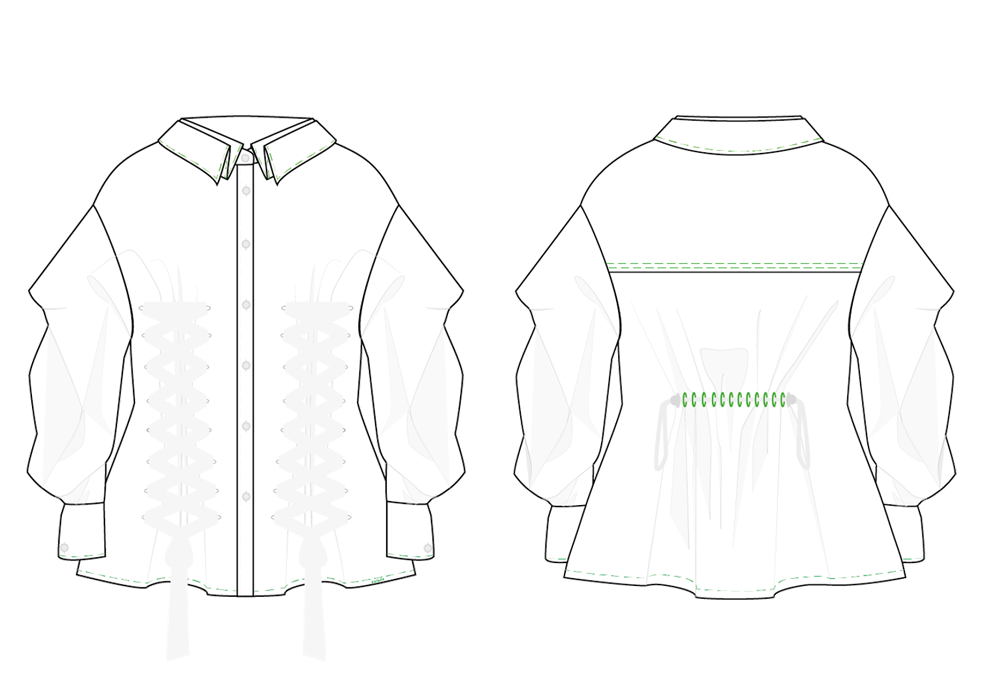
ICHI: chosen design
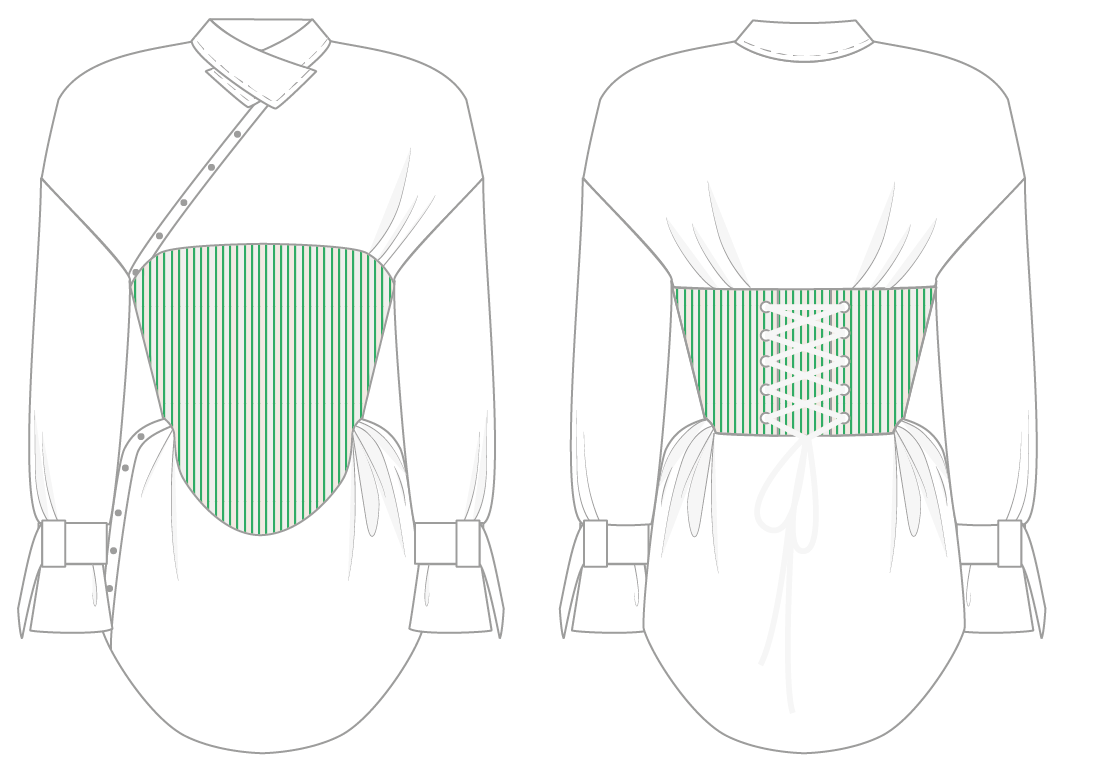
NI
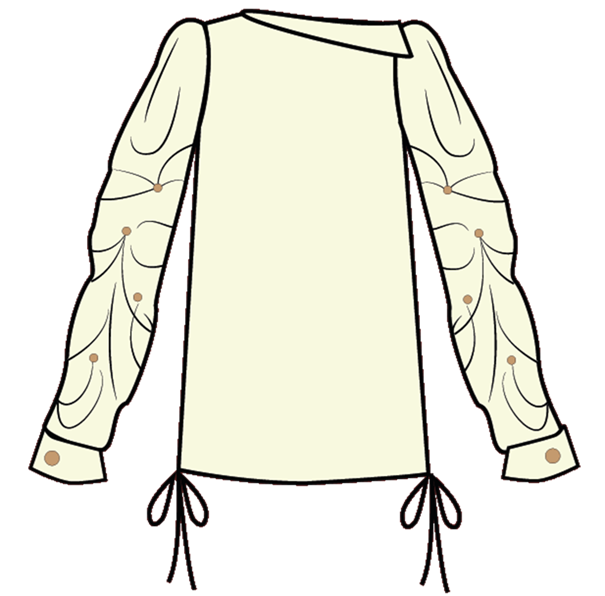
SAN
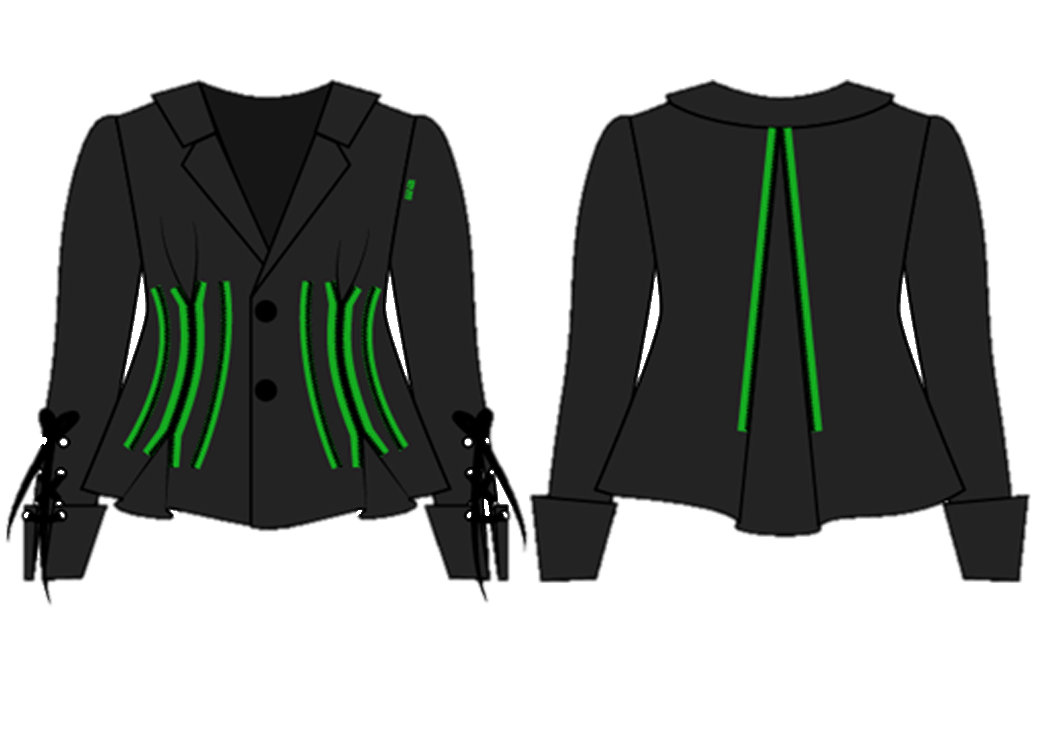
SHI

GO

ROKU
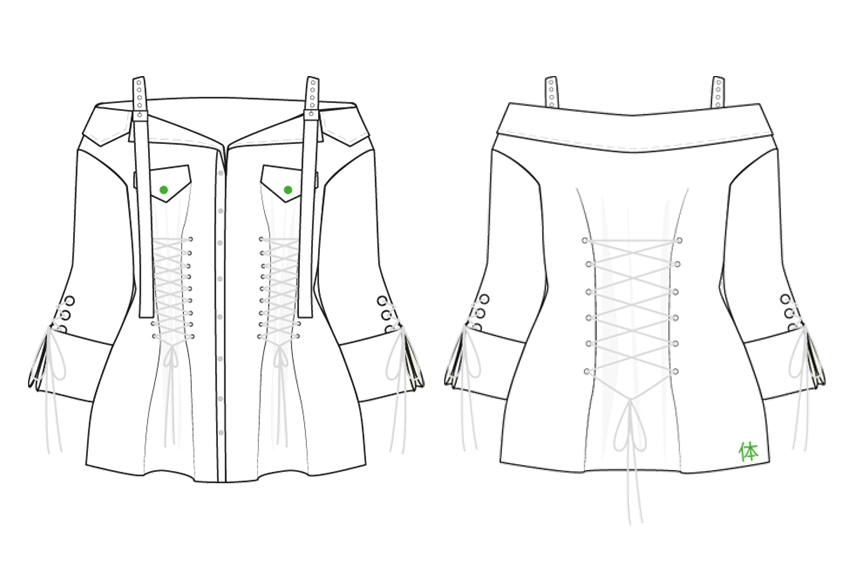
NANA
- CHOSEN DESIGN -
- ICHI -
Figure 14 : ICHI (Verhoest, 2021)
- VARIANTS -
The variants of the chosen design are named after important women in world history: Princess Diana, Marie Curie, Jane Austen and Simone de Beauvoir.
MARIE
DIANA
JANE
SIMONE
PROTOTYPE

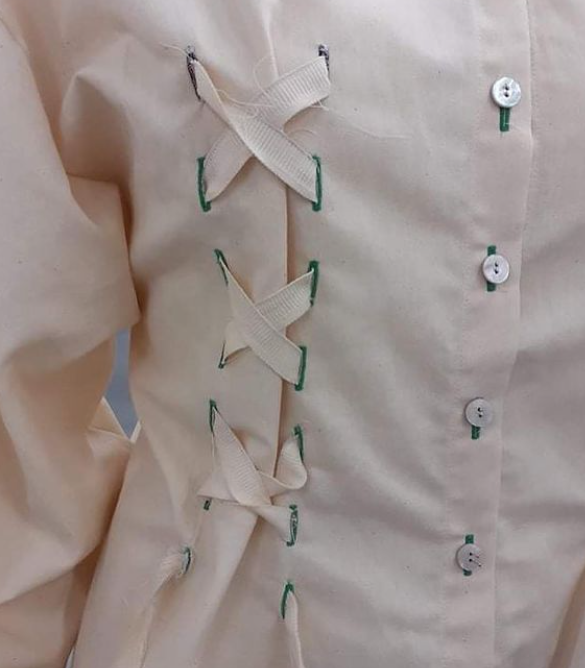
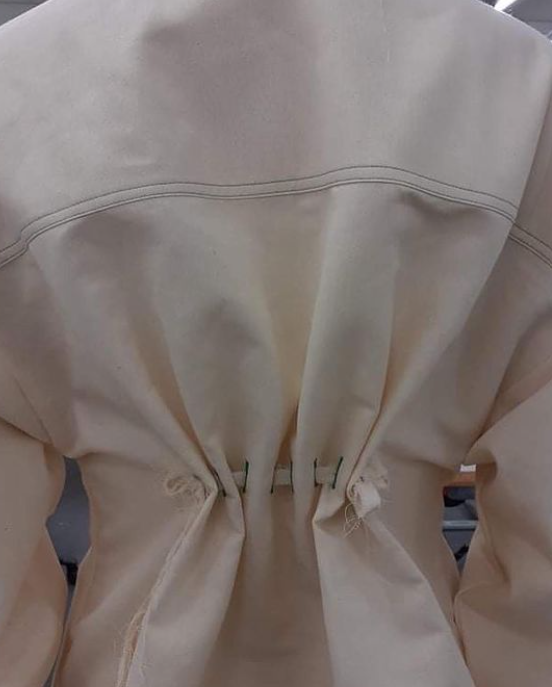
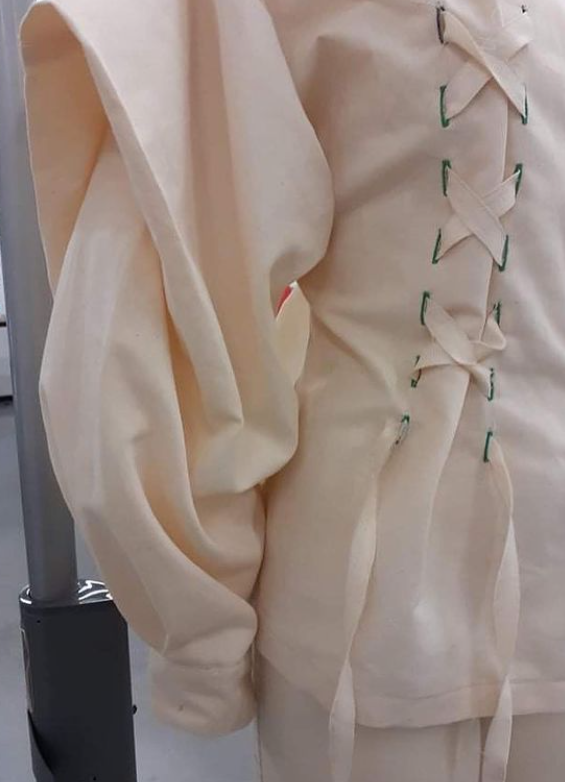
RESULTS

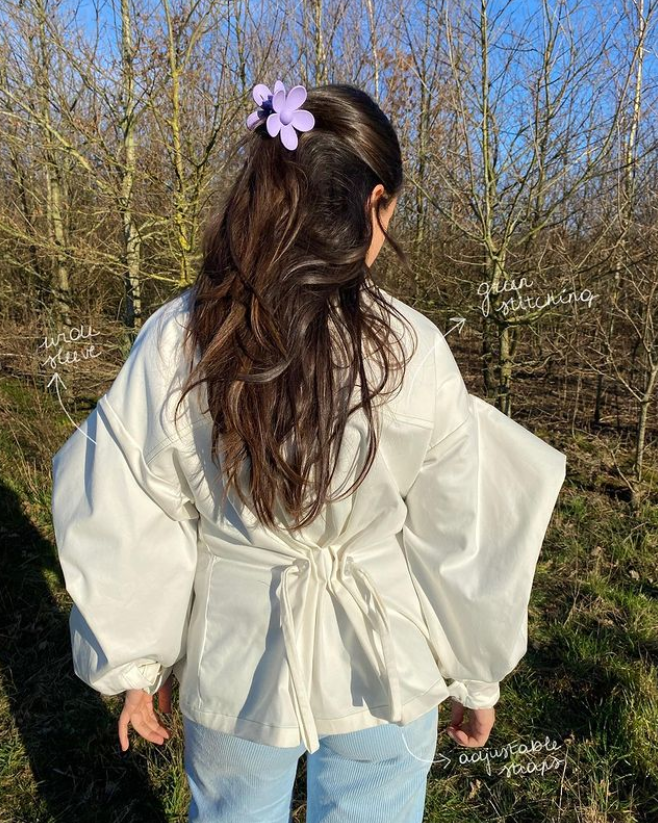
FINAL CONSIDERATIONS
As a group, we are very satisfied with our result and are looking forward to working on it further next semester. It was a very pleasant collaboration as we complimented each other nicely and everyone had an important task in the project. No one faded into the background and everyone's opinion counted in important decisions. I also feel that everyone is interested in continuing this project because we all have a feel for it.
We chose to freewheel instead of going for a call, so we had to find a problem ourselves and come up with an idea from there. There was not much doubt when this problem first came up; everyone agreed that body shaming is a big problem today, both among our own age group and older individuals. It was therefore immediately clear that we wanted to address this problem. Due to the great interest in this and our common passion for fashion, it was always exciting to work on the project, we were able to derive satisfaction from it.
In the second semester, we will mainly look for even more sustainable options for the materials, a concrete three-year plan and a clear marketing strategy. We strive for a concept that is as watertight as possible, in which all phases of the process are sustainable down to the last detail.
After all the work, the studies, the meetings, the sleep deprivation and the friendship we've built over the past few months, I'm sure we can be proud of our results.
SOCIAL
SOURCES
18mm Recycled plastic white cord stopper. (z.d.). James Tailoring. Geraadpleegd op 10 december 2021, van https://jamestailoring.co.uk/product/18mm-recycled-plastic-white-cord-stopper/
8. Waardig werk en economische groei. (2017, 30 maart). sdgs. Geraadpleegd op 14 november 2021, van https://www.sdgs.be/nl/sdgs/8-waardig-werk-en-economische-groei
Biologisch katoen. (2021). Brand Mission. Geraadpleegd op 19 november 2021, van https://www.brandmission.nl/faq/biologischkatoen
bpost. (z.d.). bpost. Geraadpleegd op 18 december 2021, van https://www.bpost.be/nl
Freshwater Mother of Pearl Buttons. (z.d.). Luméa. Geraadpleegd op 2 december 2021, van https://lumea.co/products/components/shell-buttons/freshwater-mother-of-pearl
Fusible Interlining F 220. (z.d.). Vlieseline. Geraadpleegd op 26 november 2021, van https://www.vlieseline.com/Products/Fusible-Interlinings/F-220
Gabardine van biologische katoen in kleur fog. (z.d.). Ecotex. Geraadpleegd op 23 november 2021, van https://www.ecotex.nl/contents/nl/p163698_Gabardine-biologische-katoen-in-kleur-fog.html
Gripzak Composteerbaar 150 mm x 200 mm Half doorzichtig. DaklaPack Nederland. Geraadpleegd op 15 december 2021, van https://www.daklapack.nl/gripzakken/biologisch-afbreekbare-gripzakken/gripzak-composteerbaar-150-mm-x-200-mm-half-doorzichtig/8712963031411
Grondstoffen. (2021). Close The Loop. Geraadpleegd op 19 november 2021, van https://www.close-the-loop.be/nl/phase/2/grondstoffen
Janssens, E. (2019). Vezelkennis (Vols. 2019–2020). E.J.
Marketing Toolbox. (z.d.). Budbee. Geraadpleegd op 18 december 2021, van https://budbee.com/en/marketing-toolbox/
Oeko-tex 100. (z.d.). Labelinfo. Geraadpleegd op 2 december 2021, van https://www.labelinfo.be/label/oeko-tex-100
Oscar Ortiz, O. O. (2009). Sustainability in the construction industry: A review of recent developments based on LCA. Construction and Building Materials, 23(1), 1–2. https://www.sciencedirect.com/science/article/pii/S0950061807003005
Post NL. (2019, mei). Duurzaamheidsverklaring Post NL. https://www.postnl.be/Images/duurzaamheidsverklaring-2019_tcm73-79481.pdf?version=4
Scanfil Biokatoen naaigaren. (z.d.). Pure Fabricz. Geraadpleegd op 7 december 2021, van https://www.purefabricz.com/Products/Nederlands/60-0-naaigaren-cones.aspx
Sustainability. (2021, 6 december). DPD Your delivery experts. Geraadpleegd op 19 december 2021, van https://www.dpd.com/nl/nl/sustainability/
The Loop. (2021). Close The Loop. Geraadpleegd op 31 oktober 2021, van https://www.close-the-loop.be/nl
United Nations Global Compact - 10 principes | Helliot. (2019). Helliot. Geraadpleegd op 15 december 2021, van https://www.helliot.nl/united-nations-global-compact-10-principes
Vlieseline F220. (z.d.). Fournituren Zakelijk. Geraadpleegd op 2 december 2021, van https://www.fourniturenzakelijk.nl/collections/vlieseline/products/vlieseline-f220
Waarom biologische stoffen en wat is GOTS? (z.d.). Studio Spatz. Geraadpleegd op 23 november 2021, van https://www.studiospatz.nl/waarom-biologische-stoffen-wat-is-gots/



